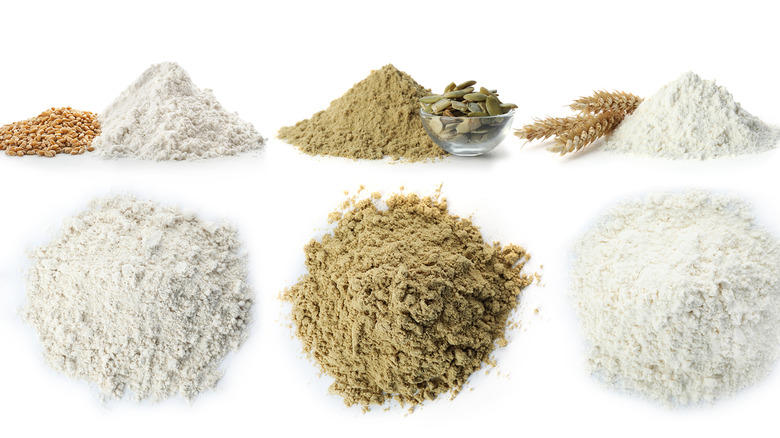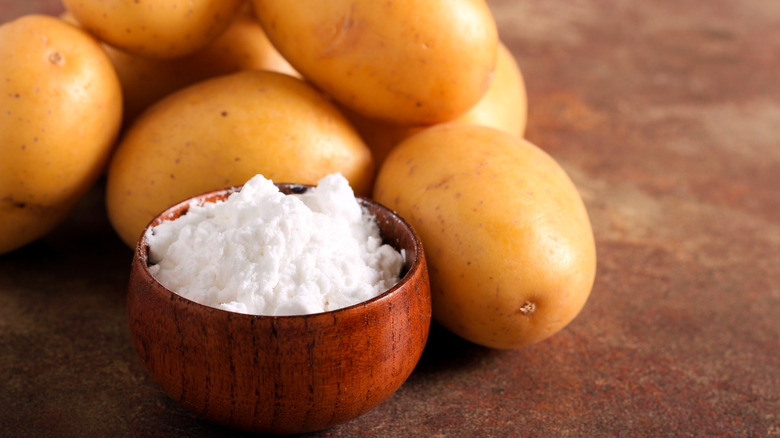The Main Difference Between Flour And Starch
The first time you learn that starch turns into sugar after you eat it, you might wonder if you've stumbled upon some sort of nutritional urban legend. However, it's 100% scientific fact, according to registered dietitian Lucy Jones (via Fab Flour). What it means is that the human body is designed to break down digestible carbohydrates into glucose, which is a type of sugar, and is then delivered into the blood and distributed, with the help of insulin, to cells throughout the entire body for use as immediate or stored energy (via the Harvard University's The Nutrition Source).
According to Healthline, there are three principal categories of carbohydrates. The first is fiber, which is non-digestible. The other two are sugar and starch. Sugars are simple chain carbohydrates, also known as simple carbohydrates. Sugars are digested more quickly than starch (scientific name: "amylum"), which is a complex chain carbohydrate (i.e., complex carbohydrate). Starch, which in its purest form is a "white, tasteless, and odorless powder," is found plentifully in grains and tubers (which include potatoes and tapioca), according to the Biology Online Dictionary, as well as starchy plant-based foods that include corn, peas, nuts, seeds, and legumes, per Diabetes.org.
Starch is also found in foods that are processed from/derived from foods containing starch. One such food is flour, which is often conflated with starch. Although the two are related and can sometimes be used interchangeably, they aren't the same.
Starch is one of two main components in flour
Both "flour" and "starch" refer to a powdery substance used in thickening soups, sauces, and stews while only minimally contributing any sort of flavor, per The Washington Post. Although flour and starch may be similar in appearance and texture, they are nevertheless distinct in their chemical and nutritional makeup, affecting how each is best deployed in cooking. Starch is one component of flour, whereas flour, by contrast, cannot even exist without starch. In addition to starch, flour's other major component is protein, according to the National Library of Medicine (NLM).
Like starch, protein acts as a thickener. However, starch and protein lend thickness in different ways. Protein does so by introducing elasticity and cohesiveness to the finished product, according to ChainBaker. In particular, what starch contributes is the process of gelatinization, according to Science of Cooking, which describes the process as a breakdown of the bonds between starch molecules that allow the introduction and absorption of water.
Because flour's starch content is diluted by protein, starch is often a better choice when thickening liquids than flour, Better Homes & Gardens (BHG) points out. However, flour's starch content varies depending upon the plant the flour is derived from. By contrast, all starch is 100% starch. What makes one starch different from another is its chemical/molecular structure, which affects precisely how any given starch will behave when mixed with liquid, as discussed below (via the Science of Cooking).
The various kinds of flours available vary in terms of starch content
Both flour and starch can be derived from any starch-containing plant. For example, potato flour derives from the whole potato, according to the Science of Cooking. The resulting powder contains potato starch, protein, sodium, and other micronutrients. By contrast, potato starch, which comprises just the starch, is derived through isolation and extraction. Just as the foods from which flour may be derived vary in their starch content, so too do the resulting flours. One of the most important things to consider when choosing which type of flour to use in any given recipe is the starch content in relation to the protein content, according to Food Network.
For example, wheat flour contains anywhere from 70-75% starch, according to the National Library of Medicine. Within that range, however, starch content differs depending on the specific wheat cultivars used and the type of flour they're being used for. Generally, wheat-based bread flour contains the least amount of starch and the most protein, while wheat-based cake flour contains the most starch and the least protein, according to registered dietitian Robert Larson Duyff, via Food & Nutrition Magazine. Accordingly, bread flour delivers a chewier, resilient bite, whereas cake flour delivers a more tender crumb. Non-wheat flours vary considerably in their starch content. Rice flour is among the highest, according to Duyff, while almond flour is one of the lowest. Learn more about this in our guide to all the flours.
Different kinds of starch vary in terms of their molecular structure
"All starches are not created equal. There are huge differences in functionality and performance between them," John Mitolo, technical service manager for National Starch & Chemical Co., told Prepared Foods. For the most part, what distinguishes one starch from another is the chemical/molecular makeup of its source plant, which affects the characteristics and quality of a given starch's gelatinization.
For example, when potato starch gelatinizes, the molecular characteristics of its starch granules allow it to dissolve thoroughly, which can be important in sauces, soups, and stews that are meant to be translucent (via Science of Cooking). Cornstarch also lends translucency. However, tapioca starch dissolves more thoroughly than corn and potato, becoming almost clear during gelatinization. That said, tapioca starch breaks down faster at higher temperatures than potato and corn starch. It's, therefore, not as useful in recipes calling for cooking at higher temperatures. Starch derived from arrowroot gelatinizes at a lower temperature than cornstarch and works best when mixed into a cool liquid before adding to a recipe calling for higher temperatures.
In addition, other characteristics of a particular starch will make it a better choice for certain recipes. For example, cornstarch's gelatinization is weakened by the presence of an acid, whereas the same is not true of arrowroot starch. On the other hand, arrowroot doesn't fully emulsify with dairy products, making it a poor choice in milk-based sauces.



